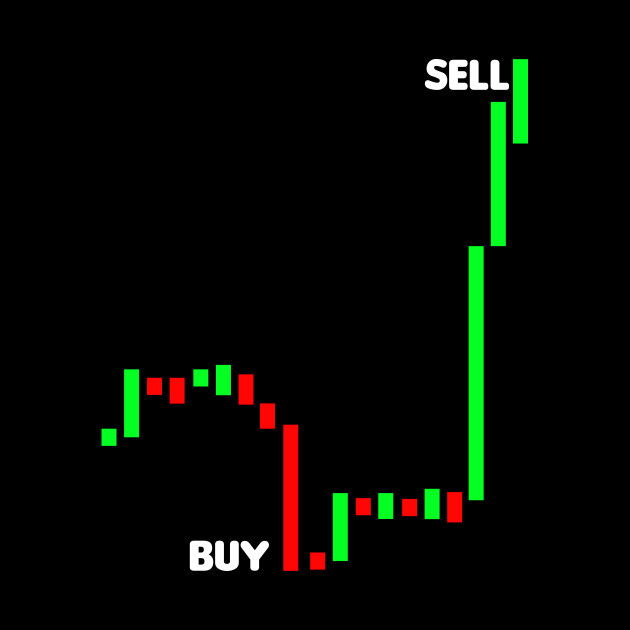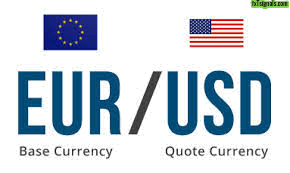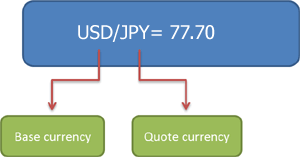
Forex trading involves trying to predict which currency will rise or fall versus another currency.
How do you know when to buy or sell a currency pair?
In the following examples, we are going to use a little fundamental analysis to help us decide whether to buy or sell a specific currency pair. The supply and demand for a currency changes due to various economic factors, which drives currency exchange rates up and down. Each currency belongs to a country (or region). So forex fundamental analysis focuses on the overall state of the country’s economy, such as productivity, employment, manufacturing, international trade, and interest rates. If you always fell asleep during your economics class or just flat out skipped economics class, don’t worry! We will cover fundamental analysis in a later lesson.
EUR/USD
 In this example, the euro is the base currency and thus the “basis” for the buy/sell. If you believe that the U.S. economy will continue to weaken, which is bad for the U.S. dollar, you would execute a BUY EUR/USD order. By doing so, you have bought euros in the expectation that it will rise versus the U.S. dollar. If you believe that the U.S. economy is strong and the euro will weaken against the U.S. dollar, you would execute a SELL EUR/USD order. By doing so, you have sold euros in the expectation that it will fall versus the US dollar.
In this example, the euro is the base currency and thus the “basis” for the buy/sell. If you believe that the U.S. economy will continue to weaken, which is bad for the U.S. dollar, you would execute a BUY EUR/USD order. By doing so, you have bought euros in the expectation that it will rise versus the U.S. dollar. If you believe that the U.S. economy is strong and the euro will weaken against the U.S. dollar, you would execute a SELL EUR/USD order. By doing so, you have sold euros in the expectation that it will fall versus the US dollar.
USD/JPY
 In this example, the U.S. dollar is the base currency and thus the “basis” for the buy/sell. If you think that the Japanese government is going to weaken the yen in order to help its export industry, you would execute a BUY USD/JPY order. By doing so you have bought U.S dollars in the expectation that it will rise versus the Japanese yen. If you believe that Japanese investors are pulling money out of U.S. financial markets and converting all their U.S. dollars back to yen, and this will hurt the U.S. dollar, you would execute a SELL USD/JPY order. By doing so you have sold U.S dollars in the expectation that it will depreciate against the Japanese yen.
In this example, the U.S. dollar is the base currency and thus the “basis” for the buy/sell. If you think that the Japanese government is going to weaken the yen in order to help its export industry, you would execute a BUY USD/JPY order. By doing so you have bought U.S dollars in the expectation that it will rise versus the Japanese yen. If you believe that Japanese investors are pulling money out of U.S. financial markets and converting all their U.S. dollars back to yen, and this will hurt the U.S. dollar, you would execute a SELL USD/JPY order. By doing so you have sold U.S dollars in the expectation that it will depreciate against the Japanese yen.
Trading in “Lots”
When you go to the grocery store and want to buy an egg, you can’t just buy a single egg, they come in dozens or “lots” of 12.
In forex, it would be just as foolish to buy or sell 1 euro, so they usually come in “lots” of 1,000 units of currency (micro lot), 10,000 units (mini lot), or 100,000 units (standard lot) depending on your broker and the type of account you have (more on “lots” later).
Margin Trading
“But I don’t have enough money to buy 10,000 euros! Can I still trade?”
You can! By using leverage.
When you trade with leverage, you wouldn’t need to pay the 10,000 euros upfront. Instead, you’d put down a small “deposit”, known as margin.
Leverage is the ratio of the transaction size (“position size”) to the actual cash (“trading capital”) used for margin. For example, 50:1 leverage, also known as a 2% margin requirement, means $2,000 of margin is required to open a position size worth $100,000.
Margin trading lets you open large position sizes using only a fraction of the capital you’d normally need.
This is how you’re able to open $1,250 or $50,000 positions with as little as $25 or $1,000.
You can conduct relatively large transactions with a small amount of initial capital.
Let us explain.
We will be discussing margin in more detail later, but hopefully, you’re able to get the basic idea of how it works. Listen carefully because this is very important!
- You believe that signals in the market are indicating that the British pound will go up against the U.S. dollar.
- You open one standard lot (100,000 units GBP/USD), buying with the British pound with a 2% margin requirement.
- You wait for the exchange rate to climb.
- When you buy one lot (100,000 units) of GBP/USD at a price of 1.50000, you are buying 100,000 pounds, which is worth $150,000 (100,000 units of GBP * 1.50000).
- Since the margin requirement was 2%, then US$3,000 would be set aside in your account to open up the trade ($150,000 * 2%).
- You now control 100,000 pounds with just $3,000.
- Your predictions come true and you decide to sell. You close the position at 1.50500. You earn about $500.
